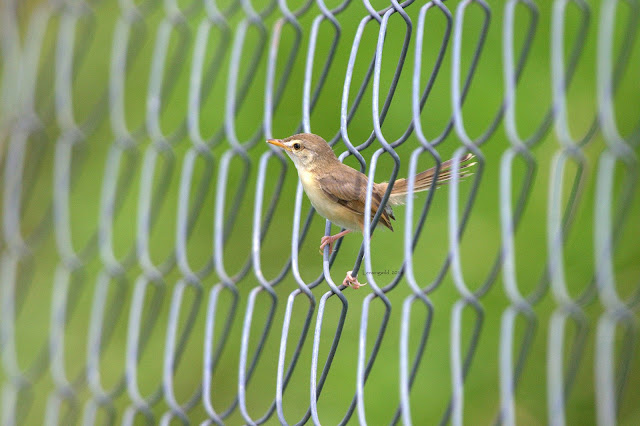Trumpeter Swans with Cygnets
This afternoon when I was driving in the Parks highway, I saw that roadside lake just outside Fairbanks and somehow I wanted to go there again. It was a private property. Hence, I parked my car and biked all the way to the lake to see nothing interesting except more water due to the recent showers. Since I was with my bike, I decided to go further in the mud road that went into the woods. After 1 km I saw a two crushers and earth movers making gravels out of the rocks. As the mud road goes to the other side, I followed a discarded way which seemed to go down to a valley that was covered by thick vegetation and tall trees. This way seemed to be not in use for long time and trees and small plants started to cover the once used clearing. But biking was not a problem in that place. After 2 km it ended in one side of a big lake. I don’t know whether it is a natural lake or a huge pit created after removal of rocks and dirt for commercial use.

Part of the lake
But it was huge and looked like a natural lake with all water plants and birds. It was really wild and undisturbed due to the distance from the road and poor accessibility. While I was watching the lake and its surroundings, a loon noticed me and raised an alarm which was promptly returned by another loon from the far end of the lake.
To my surprise at the other side of lake I noticed two adult swans and two juveniles in the water. The scene was like a painting and the swans were far away from me and unreachable due to water and swampy landscape. The swans first reacted to my presence by hiding their juveniles in the tall grasses.
I managed to reach somehow closer through the thick vegetation that made the alarmed swans to move further away. I took some photos of the swans and a grebe.
Latter, I learned that the swans were Trumpeter Swans which were in the brink of extinction due to heavy hunting. Now they are mostly preserved in captivity and being reintroduced into many of the North American habitats. I was happy to see a pair of swans with their juveniles in wild habitat.

Some interesting facts about the Trumpeter Swans:
Part of the lake
But it was huge and looked like a natural lake with all water plants and birds. It was really wild and undisturbed due to the distance from the road and poor accessibility. While I was watching the lake and its surroundings, a loon noticed me and raised an alarm which was promptly returned by another loon from the far end of the lake.
Loon that alarmed the birds
To my surprise at the other side of lake I noticed two adult swans and two juveniles in the water. The scene was like a painting and the swans were far away from me and unreachable due to water and swampy landscape. The swans first reacted to my presence by hiding their juveniles in the tall grasses.
I managed to reach somehow closer through the thick vegetation that made the alarmed swans to move further away. I took some photos of the swans and a grebe.
Grebe
The loons were crying continuously and following me in the water. I was watching the swans for a while. The adult swans were about 3 feet tall (above water) and bigger in size than any other waterfowl that I have ever seen. They were very calm, gentle but very alert. They were swimming very elegantly but quickly. While the adults were concerned about my presence, the juveniles were following their parents and eating some water plants. The adults were very keen on protecting their young ones and watching all the directions with vigil.
The loons were crying continuously and following me in the water. I was watching the swans for a while. The adult swans were about 3 feet tall (above water) and bigger in size than any other waterfowl that I have ever seen. They were very calm, gentle but very alert. They were swimming very elegantly but quickly. While the adults were concerned about my presence, the juveniles were following their parents and eating some water plants. The adults were very keen on protecting their young ones and watching all the directions with vigil.
Latter, I learned that the swans were Trumpeter Swans which were in the brink of extinction due to heavy hunting. Now they are mostly preserved in captivity and being reintroduced into many of the North American habitats. I was happy to see a pair of swans with their juveniles in wild habitat.
Some interesting facts about the Trumpeter Swans:
- The trumpeter is the world's largest member of the waterfowl family.
- Its largest flight feathers made what were considered to be the best quality quill pens.
- Trumpeters are assumed to mate for life, but some individuals do switch mates over their lifetimes. Some males that lost their mates did not mate again.
- The diet is almost entirely aquatic plants. The young (Cygnets) are fed on insects and small crustaceans along with plants at first, changing to a vegetation-based diet over the first few months.
www.adfg.state.ak.us/pubs/notebook/bird/swans.php
en.wikipedia.org/wiki/Trumpeter_Swan
http://www.birds.cornell.edu/AllAboutBirds/BirdGuide/Trumpeter_Swan_dtl.html#fig1


Comments